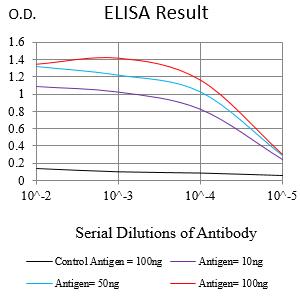
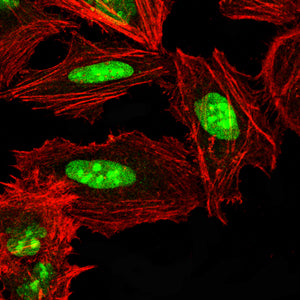
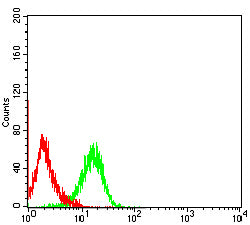
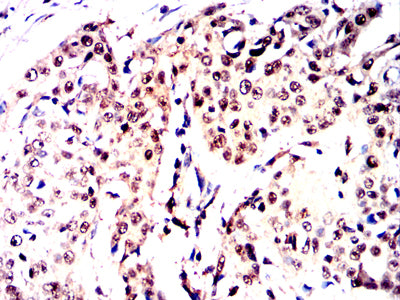
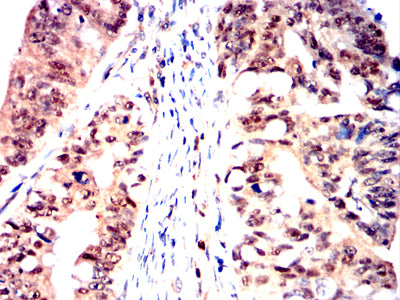
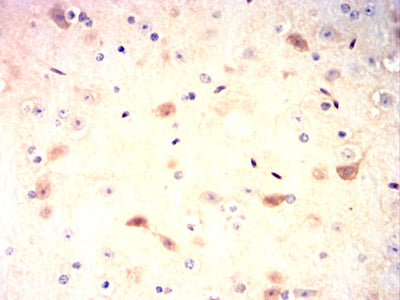
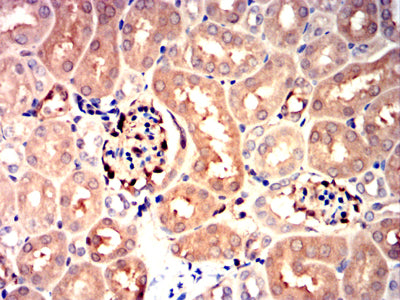
| WB | 咨询技术 | Human,Mouse,Rat |
| IF | 咨询技术 | Human,Mouse,Rat |
| IHC | 1/200 - 1/1000 | Human,Mouse,Rat |
| ICC | 1/50 - 1/200 | Human,Mouse,Rat |
| FCM | 1/200 - 1/400 | Human,Mouse,Rat |
| Elisa | 1/10000 | Human,Mouse,Rat |
| Aliases | PORMIN; TMEM123 |
| Entrez GeneID | 10360 |
| clone | 2A3B1 |
| WB Predicted band size | 19kDa |
| Host/Isotype | Mouse IgG1 |
| Antibody Type | Primary antibody |
| Storage | Store at 4°C short term. Aliquot and store at -20°C long term. Avoid freeze/thaw cycles. |
| Species Reactivity | Human, Mouse |
| Immunogen | Purified recombinant fragment of human NPM3 (AA: full 1-178) expressed in E. Coli. |
| Formulation | Purified antibody in PBS with 0.05% sodium azide |
+ +
以下是关于NPM3抗体的3篇参考文献示例(注:以下为模拟内容,具体文献需根据实际检索补充):
---
1. **文献名称**:*NPM3 regulates ribosome biogenesis and cell proliferation via rRNA processing*
**作者**:Smith A, et al.
**摘要**:研究揭示NPM3在核糖体RNA加工中的关键作用,通过敲除实验和NPM3特异性抗体(Western blot/免疫荧光)验证其与核仁蛋白的相互作用,表明其异常表达与细胞周期失调相关。
2. **文献名称**:*Development of a monoclonal antibody against NPM3 for cancer diagnostics*
**作者**:Chen L, et al.
**摘要**:报道一种新型NPM3单克隆抗体的开发与验证,用于免疫组化检测多种肿瘤组织中NPM3的过表达,提示其作为癌症生物标志物的潜力。
3. **文献名称**:*NPM3 deficiency disrupts embryonic stem cell differentiation*
**作者**:Wang Y, et al.
**摘要**:利用NPM3抗体进行染色质免疫沉淀(ChIP)和蛋白定位分析,发现NPM3缺失导致胚胎干细胞多能性相关基因表达异常,影响分化过程。
---
如需具体文献,建议通过PubMed或Google Scholar检索关键词“NPM3 antibody”或“Nucleophosmin 3 antibody”获取最新研究。
NPM3 (Nucleophosmin/Nucleoplasmin 3) is a member of the nucleophosmin/nucleoplasmin family, which plays critical roles in chromatin remodeling, histone chaperoning, and ribosome biogenesis. Unlike its well-studied homolog NPM1 (linked to cancer and ribosome assembly), NPM3 remains less characterized but shares structural features, including acidic domains for histone binding and nucleolar localization signals. It is implicated in early embryonic development, oocyte maturation, and epigenetic regulation, potentially through interactions with histones or transcription factors.
NPM3 antibodies are essential tools for studying its expression, localization, and molecular interactions. They enable detection via techniques like Western blot, immunofluorescence, and immunohistochemistry, aiding research on its role in cellular processes and diseases. Dysregulation of NPM3 has been tentatively associated with cancer (e.g., gliomas, leukemia) and developmental disorders, though mechanistic insights remain limited. Commercial antibodies typically target specific epitopes, such as the N-terminal region, and require validation for species cross-reactivity (human, mouse, rat). Recent studies also explore NPM3’s potential as a biomarker or therapeutic target, emphasizing the need for reliable antibodies to decipher its biological and pathological significance.
×